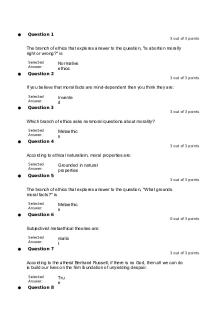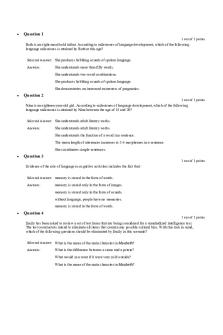QUIZ Assignment 8 PDF

| Title | QUIZ Assignment 8 |
|---|---|
| Author | John Wang |
| Course | Astronomy I Our Place in the Cosmos |
| Institution | Wilfrid Laurier University |
| Pages | 4 |
| File Size | 111.1 KB |
| File Type | |
| Total Downloads | 67 |
| Total Views | 114 |
Summary
quiz assignment answers...
Description
1
WILFRID LAURIER UNIVERSITY AS101a Chapter 8 Quiz # 8 Instructor: Dr. Ioannis Haranas 1. As a star exhausts the hydrogen in its core, what happens? a. It becomes hotter and more luminous. b. It becomes hotter and less luminous. c. It becomes cooler and less luminous. *d. It becomes cooler and more luminous. 2. When does a star experience helium fusion? a. just before it enters the main sequence b. after it has become a red giant star *c. when it is on the horizontal branch d. before it leaves the main sequence 3. Why are giant and supergiant stars rare? *a. The giant and supergiant stages are very short. b. The star blows up before the giant or supergiant stage is reached. c. They do not form as often as main sequence stars. d. The giant or supergiant stage is very long. 4. Which of the following statements best describes why stars eventually die? a. Their lifespan is limited. *b. They exhaust all their fuel. c. Their cores become hotter. d. They become less luminous. 5. Which of the following occurs during the giant stage? *a. helium fusion in the core and hydrogen fusion in the surrounding shell b. hydrogen fusion in the core and helium fusion in the surrounding shell c. hydrogen and helium fusion in the core d. hydrogen flash 6. In what way are giants and supergiants similar? a. They are the main sequence stars. b. They undergo a helium flash stage as they enter the main sequence. *c. They are very luminous. d. Their cores expand rapidly to reach giant sizes.
2
7. What do we call the region of the HR diagram that represents giant stars that are fusing helium in their cores and then in their shells? a. turnoff point *b. horizontal branch c. turn-on point d. main sequence 8. Why are star clusters important to our study of stars? a. because all stars formed in star clusters *b. because they allow us to test our theories and models of stellar evolution c. because the Sun was once a member of a globular cluster d. because they are the only objects that contain Cepheid variables 9. What property is the same for all stars in a star cluster? *a. age b. mass c. luminosity d. radius 10. Which point indicates the location on the H-R diagram of a one-solar-mass star when it stars
to fuse helium?
a. 1 b. 2 c. 3 *d. 4 11. Why can’t the lowest mass stars become giants? *a. Their centers never get hot enough. b. Their rotation is too slow. c. They do not contain helium. d. They never use up their hydrogen.
12. How is a giant star different from the star it evolved from?
3
a. A giant is hotter and more luminous. b. A giant is hotter and less luminous. *c. A giant is cooler and more luminous. d. A giant is cooler and less luminous. 13. After they leave the main sequence, what happens to stars with masses between 0.4 and 4
solar masses? *a. They undergo thermonuclear fusion of hydrogen and helium, but never get hot enough to ignite carbon. b. They undergo thermonuclear fusion of hydrogen, but never get hot enough to ignite helium. c. They produce type-I supernovae after they exhaust their nuclear fuels. d. They produce type-II supernovae after they exhaust their nuclear fuels. 14. About how long will a 0.5 solar mass star spend on the main sequence? a. 5 million years b. 570 million years c. 5 billion years *d. 57 billion years 15. For a star with a mass similar to that of the Sun, what is the last stage of the nuclear fusion? a. hydrogen to helium *b. helium to carbon and oxygen c. carbon to magnesium d. silicon to iron 16. A low mass star goes through several stages of life from birth to death. Which of the
following lists are in correct order? a. protostar, main sequence star, red giant, supernova, neutron star b. protostar, main sequence star, planetary nebula, super giant, supernova *c. protostar, main sequence star, red giant, planetary nebula, white dwarf d. protostar, main sequence star, white dwarf, red giant 17. What happens to stars that have ejected a planetary nebula? a. They become protostars. b. They become brown dwarfs. *c. They become white dwarfs. d. They become red giants.
18. After what evolutionary stage does a star become a white dwarf?
4
a. protostar b. pre-main sequence c. main sequence *d. giant 19. What is a planetary nebula? *a. the expelled outer envelope of a medium mass star b. a cloud of hot gas produced by a supernova explosion c. a nebula within which planets are forming d. a cloud of hot gas surrounding a planet
20. What does a planetary nebula do? a. produces an absorption spectrum *b. produces an emission spectrum c. contracts to form planets d. contracts to form a star 21. What is the term for a collection of 100 to 1000 young stars in a region about 80 light-years
in diameter? a. Herbig-Haro object b. globular cluster *c. open cluster d. giant cluster
GOOD LUCK!!...
Similar Free PDFs

QUIZ Assignment 8
- 4 Pages

Quiz 8 - Quiz 8
- 4 Pages

Quiz 8 - Weekly Quiz
- 6 Pages

Quiz Chapter 8 - Quiz
- 6 Pages

Quiz-8 - QUIZ
- 22 Pages

Buslaw QUIZ 8 - Quiz
- 6 Pages

Chapter 8 quiz #8
- 3 Pages

Quiz 8 - Chapter 8 Quiz Solved.
- 2 Pages

Chapter 8 Quiz - Weekly Quiz
- 3 Pages

Acctg quiz 8 - Accounting quiz
- 2 Pages

Week 8 quiz - Week 8
- 19 Pages

Assignment 8
- 2 Pages

Assignment 8
- 1 Pages

Assignment 8
- 3 Pages

Assignment 8
- 1 Pages
Popular Institutions
- Tinajero National High School - Annex
- Politeknik Caltex Riau
- Yokohama City University
- SGT University
- University of Al-Qadisiyah
- Divine Word College of Vigan
- Techniek College Rotterdam
- Universidade de Santiago
- Universiti Teknologi MARA Cawangan Johor Kampus Pasir Gudang
- Poltekkes Kemenkes Yogyakarta
- Baguio City National High School
- Colegio san marcos
- preparatoria uno
- Centro de Bachillerato Tecnológico Industrial y de Servicios No. 107
- Dalian Maritime University
- Quang Trung Secondary School
- Colegio Tecnológico en Informática
- Corporación Regional de Educación Superior
- Grupo CEDVA
- Dar Al Uloom University
- Centro de Estudios Preuniversitarios de la Universidad Nacional de Ingeniería
- 上智大学
- Aakash International School, Nuna Majara
- San Felipe Neri Catholic School
- Kang Chiao International School - New Taipei City
- Misamis Occidental National High School
- Institución Educativa Escuela Normal Juan Ladrilleros
- Kolehiyo ng Pantukan
- Batanes State College
- Instituto Continental
- Sekolah Menengah Kejuruan Kesehatan Kaltara (Tarakan)
- Colegio de La Inmaculada Concepcion - Cebu
